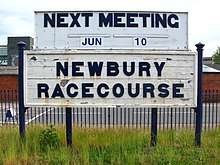Newbury Racecourse railway station
Newbury Racecourse railway station serves the East Fields area of the town of Newbury, Berkshire, England, and the adjacent Newbury Racecourse. It is 52 miles 31 chains (84.31 km) measured from London Paddington. It was opened on 26 September 1905.
| Newbury Racecourse | |
|---|---|
 | |
| Location | |
| Place | East Fields, Newbury |
| Local authority | West Berkshire |
| Coordinates | 51.398°N 1.308°W |
| Grid reference | SU482668 |
| Operations | |
| Station code | NRC |
| Managed by | Great Western Railway |
| Number of platforms | 3 |
| DfT category | F1 |
| Live arrivals/departures, station information and onward connections from National Rail Enquiries | |
| Annual rail passenger usage* | |
| 2014/15 | |
| 2015/16 | |
| 2016/17 | |
| 2017/18 | |
| 2018/19 | |
| History | |
| Key dates | Opened 26 September 1905 |
| Original company | Great Western Railway |
| National Rail – UK railway stations | |
| * Annual estimated passenger usage based on sales of tickets in stated financial year(s) which end or originate at Newbury Racecourse from Office of Rail and Road statistics. Methodology may vary year on year. | |
As the station is next to the racecourse it handles heavy traffic and additional trains on race days. Otherwise, the station is served by local services operated by Great Western Railway between Reading and Newbury and Bedwyn.
Services
Newbury Racecourse station is served by local services operated by Great Western Railway from Reading to Newbury. On the current weekly timetable only two or three local services that call at the station continue to Bedwyn.[1]
Services are summarised as follows.
| Preceding station | Following station | |||
|---|---|---|---|---|
| Thatcham | Great Western Railway Reading to Newbury |
Newbury | ||
During race meets or large events at Newbury Racecourse additional trains serve the station. They include a shuttle service to Reading and an extra stop for services that do not normally call at the station. During some races, a special charter calls at the station. The special trains and the shuttle service usually use the third platform on the south side of the station.
History
The Great Western Railway opened the station on 26 September 1905, several decades after the rest of the stations on this part of the line. It was used for race specials only. It did not even appear on timetables until 1912 but even then, it was still used only for race traffic.
In 1990, after the building of new facilities at the racecourse and the building of a new industrial estate on Hambridge Road, a regular stopping service was introduced for the station.[2]

The station originally had four platforms. The additional platform was on the south-facing side of what is now platform two. The platform on the south side also included station buildings and a roof through which passengers passed to access the racecourse. There was also a turntable at the station used mainly for turning steam locomotives that had brought specials at the start of the race day so they could make the return journey.[3]
Service history
The station was part of the GWR until railway nationalisation in 1948. After the sectorisation of British Rail in 1982, the station became part of Network SouthEast. Thames Trains provided services from 1996 until it became part of First Great Western Link in 2004 and First Great Western in 2006.
Current layout
The station now has three platforms, two of which are next to the main line. The third platform is on the southern side of the station on a loop. The loop that previously served the fourth platform has now been lifted.
The two main platforms that are currently served by stopping services have been shortened by fencing off the unused parts of the platform. Only short Class 166 DMUs and Class 165 DMUs use these platforms so maintaining their full length is unnecessary. Longer trains can use the third platform.
A footbridge links all the existing platforms. There is a car park on the north side of the station with access to Hambridge Road. The car park on the south side of the station is on the property of Newbury Racecourse.
Freight trains use the existing loop to allow passenger trains to pass them on the main line. Steam locomotives on special charters that are not stopping in the station also use the loop as a water stop because nearby road access can allow a water tender to reach the line. It also prevents such trains from blocking the main line or a platform at Newbury. All continuing trains using the loop at the racecourse must also travel through the loop on the down platform at Newbury to rejoin the main line.
References
| Wikimedia Commons has media related to Newbury Racecourse railway station. |
- "Timetable D" (PDF). First Great Western. 2 May 2007. Retrieved 2 September 2007.
- "Basingstoke Railway History in Maps". Christopher Tolley. 2001. Archived from the original on 6 December 2008. Retrieved 20 February 2015.
- Robertson, K (1987). The Last Days of Steam in Berkshire. Alan Sutton Publishing. ISBN 0-86299-395-4.